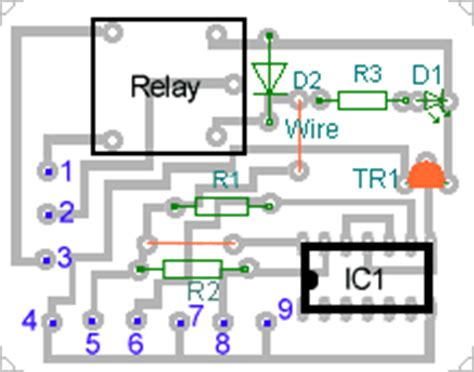Introduction to Touch Switch Circuits
Touch switch circuits are a fascinating and practical application of simple electronic components. These circuits allow you to control various devices by simply touching a designated area, eliminating the need for mechanical switches. In this article, we will explore the fundamentals of touch switch circuits and guide you through the process of building your own.
What is a Touch Switch Circuit?
A touch switch circuit is an electronic circuit that detects the presence of a human touch and triggers a specific action, such as turning on an LED or activating a relay. Unlike traditional mechanical switches that require physical pressure, touch switches rely on the capacitive sensing principle.
How Do Touch Switch Circuits Work?
Touch switch circuits work by exploiting the capacitive sensing principle. The human body has a natural capacitance, which means it can store a small amount of electrical charge. When you touch a conductive surface connected to a touch switch circuit, your body’s capacitance alters the circuit’s capacitance, triggering the switch.
Components Required for a Touch Switch Circuit
To build a touch switch circuit, you will need the following components:
- Resistors
- Capacitors
- Transistors
- Diodes
- LEDs
- Breadboard
- Jumper wires
Resistors
Resistors are essential components in touch switch circuits. They limit the current flow and help in setting the sensitivity of the touch sensor. The choice of resistor values depends on the specific circuit design and the desired sensitivity.
Capacitors
Capacitors play a crucial role in touch switch circuits. They store electrical charge and help in filtering out unwanted noise and interference. The capacitance value determines the circuit’s response time and sensitivity.
Transistors
Transistors act as switches in touch switch circuits. They amplify the small changes in capacitance caused by a human touch and control the flow of current to the output device, such as an LED or a relay.
Diodes
Diodes are used in touch switch circuits to protect the components from reverse polarity and to prevent current from flowing in the wrong direction. They ensure the proper functioning and longevity of the circuit.
LEDs
LEDs (Light Emitting Diodes) are commonly used as output devices in touch switch circuits. They provide visual feedback when the touch sensor is activated. You can choose LEDs of different colors and sizes based on your preference.
Breadboard and Jumper Wires
A breadboard is a prototyping tool that allows you to build and test electronic circuits without the need for soldering. Jumper wires are used to make connections between components on the breadboard.
Building a Simple Touch Switch Circuit
Now that we have covered the components required, let’s dive into building a simple touch switch circuit.
Step 1: Gather the Components
- 1x 10kΩ resistor
- 1x 1MΩ resistor
- 1x 100nF capacitor
- 1x BC547 NPN transistor
- 1x 1N4148 diode
- 1x LED
- 1x Breadboard
- Jumper wires
Step 2: Build the Circuit
- Connect one end of the 1MΩ resistor to the positive rail of the breadboard.
- Connect the other end of the 1MΩ resistor to one end of the 100nF capacitor and the base of the BC547 transistor.
- Connect the other end of the 100nF capacitor to the negative rail of the breadboard.
- Connect the emitter of the BC547 transistor to the negative rail.
- Connect one end of the 10kΩ resistor to the collector of the BC547 transistor.
- Connect the other end of the 10kΩ resistor to the anode of the LED.
- Connect the cathode of the LED to the positive rail through the 1N4148 diode (cathode of the diode connected to the LED, anode connected to the positive rail).
Step 3: Test the Circuit
- Power the circuit by connecting the positive rail to a voltage source (e.g., a battery or a power supply).
- Touch the exposed end of the 1MΩ resistor connected to the capacitor and transistor base.
- Observe the LED. It should light up when you touch the designated area.
Congratulations! You have successfully built a simple touch switch circuit.

Advanced Touch Switch Circuits
While the simple touch switch circuit is a great starting point, there are more advanced designs that offer improved sensitivity, noise immunity, and additional features.
Capacitive Touch Switch with Adjustable Sensitivity
This circuit allows you to adjust the sensitivity of the touch sensor using a potentiometer. By varying the resistance of the potentiometer, you can fine-tune the circuit’s response to different levels of touch.
Components required:
– 1x 100kΩ potentiometer
– 1x 1MΩ resistor
– 1x 100nF capacitor
– 1x BC547 NPN transistor
– 1x 1N4148 diode
– 1x LED
– 1x Breadboard
– Jumper wires
Circuit diagram:
+-----+
| |
||| <------- 100kΩ potentiometer
| |
+-----+
|
||| <------ 1MΩ resistor
|
+-----+-----+
| |
|||| <------- 100nF capacitor
| |
+-----------+
|
|
||| <------ BC547 transistor (base)
|
+-----------+
| |
LED 1N4148 diode
| |
+-----------+
|
|||
|
GND
Touch Switch with Debounce
Debouncing is a technique used to eliminate false triggering caused by noise or rapid multiple touches. This circuit incorporates a debounce mechanism to ensure stable and reliable switching.
Components required:
– 1x 10kΩ resistor
– 1x 1MΩ resistor
– 1x 100nF capacitor
– 1x 10µF capacitor
– 1x BC547 NPN transistor
– 1x 1N4148 diode
– 1x LED
– 1x Breadboard
– Jumper wires
Circuit diagram:
+-----+-----+
| |
|||| <------- 1MΩ resistor
| |
+-----------+
|
|||
||| <------ 100nF capacitor
|
|
||| <------ BC547 transistor (base)
|
+-----+-----+
| |
|||| ||||
| |
10kΩ 10µF
resistor capacitor
| |
+-----------+
|
|||
|
LED
|
1N4148 diode
|
|||
|
GND
Frequently Asked Questions (FAQ)
-
What is the purpose of a touch switch circuit?
A touch switch circuit allows you to control devices by simply touching a designated area, eliminating the need for mechanical switches. -
How does a touch switch circuit detect human touch?
Touch switch circuits rely on the capacitive sensing principle. When you touch a conductive surface connected to the circuit, your body’s capacitance alters the circuit’s capacitance, triggering the switch. -
Can I use different components than the ones mentioned in the article?
Yes, you can use different components with similar specifications. However, make sure to adjust the circuit design accordingly and verify the compatibility of the components. -
What are some applications of touch switch circuits?
Touch switch circuits find applications in various fields, such as: - Home automation: Controlling lights, fans, and appliances.
- Consumer electronics: Touch-based controls in devices like smartphones, tablets, and wearables.
- Interactive displays: Touch-sensitive panels and exhibits in museums and public spaces.
-
Industrial control: Touch-based interfaces for machinery and equipment control.
-
Can I integrate a touch switch circuit with a microcontroller?
Yes, touch switch circuits can be easily integrated with microcontrollers like Arduino or Raspberry Pi. You can use the touch switch as an input to the microcontroller and program it to perform specific actions based on the touch input.
Conclusion
Touch switch circuits offer a convenient and intuitive way to control devices without the need for physical buttons or switches. By understanding the basic principles and components involved, you can build your own touch switch circuits and incorporate them into various projects.
Remember to experiment, modify, and expand upon the circuits presented in this article. There are endless possibilities when it comes to designing touch-based interfaces and controls.
Happy circuit building!
